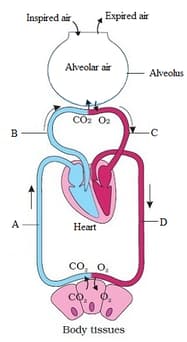HARD
NEET
IMPORTANT
Earn 100
Consider the following statements each with two blanks.
(i) Actually, only about ___(1)____ mL of air enters the lung alveoli for the exchange of gases. The remaining fills the respiratory passage and is termed ___(2)____.
(ii) The amount of air which one can inhale with maximum effort and also exhale with maximum effort is termed as ___(3)____. It is about ___(4)____ in normal adult person.
(iii) During normal quiet breathing, on an average, approximately ___(5)____ mL of air is inspired or expired by adult human male in each breath. It is termed as ___(6)____ volume.
Which of the following options gives the correct fill ups for the respective blank numbers from (1) to (6) in the above statements?
(a)
(1)-350mL , (2)-dead space air, (3)-vital capacity, (4)-4000mL , (5)-500mL , (6)-tidal volume
(b)(1)- 100mL , (2)-residual volume, (3)-functional residual capacity, (4)- 3000mL, (5)1000mL, (6)- inspiratory reserve
(c)(1)- 350mL, (2)-dead space air, (3)-vital capacity, (4)- 4000mL, (5)- 1000mL , (6)-inspiratory reserve
(d)(1)- 350 , (2)-residual volume, (3)-vital capacity, (4)- 4000mL (5)-500mL , (6)- tidal volume
50% studentsanswered this correctly

Important Questions on Breathing and Exchange of Gases
EASY
NEET
IMPORTANT
The inspiratory reserve volume tidal volume expiratory reserve volume is the same as
EASY
NEET
IMPORTANT
Vital capacity of lungs is
EASY
NEET
IMPORTANT
After forceful inspiration, the amount of air that can be breathed out by maximum forced expiration is equal to
MEDIUM
NEET
IMPORTANT
Match column I with II and select the correct option from the given codes.
| I | II | ||
|---|---|---|---|
| Tidal volume | of air | ||
| Inspiratory reserve volume | of air | ||
| Expiratory reserve volume | of air | ||
| Residual volume | of air | ||
| Vital capacity | of air |
MEDIUM
NEET
IMPORTANT
Match column I with II and select the correct option from the codes given below.
| I | II | ||
|---|---|---|---|
| Expiratory capacity | |||
| Total lung capacity | |||
| Functional residual capacity |
MEDIUM
NEET
IMPORTANT
Consider the following four statements (i - iv) and select the correct option stating which ones are true (T) and which ones are false (F).
(i) Formation of oxyhaemoglobin occurs on alveolar surface.
(ii) During gaseous exchange the gases diffuse from high partial pressure to low partial pressure.
(iii) Carbon dioxide cannot be transported with haemoglobin.
(iv) Earthworm respires through parapodia.
EASY
NEET
IMPORTANT
The exchange of gases in the alveoli of the lungs takes place by
MEDIUM
NEET
IMPORTANT
The given figure shows a diagrammatic representation of the exchange of gases at the alveolus and the body tissues with blood and the transport of oxygen and carbon dioxide. Identify the blood vessels A to D.

